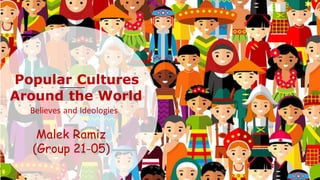
Popular cultural tribes around the world
- 1. Popular Cultures Around the World Believes and Ideologies Malek Ramiz (Group 21-05)
- 3. • Location: Namibia, Africa Semi-nomadic, the Himba live scattered across northwest Namibia and southern Angola. When stationary, they live in tipi-shaped structures built with mud and dung. Curious fact: They keep an ancestral fire burning 24 hours a day in homage to their god Mukuru. Wealth is measured in cattle, but goat is a more regular part of the diet. Future outlook: There's an estimated 20,000 to 30,000 members of the tribe left, but they're constantly threatened by new development. Nevertheless, many maintain their traditional lifestyle.
- 5. Location : Meghalaya, India The Khasi people ("Children of the Seven Huts"), are an indigenous ethnic group of Meghalaya in north-eastern India, with a significant population in the bordering state of Assam, and in certain parts of Bangladesh. Like the Japanese, the Khasis use the Rooster as a symbol because they believe that it was he who aroused God and also humbly paved and cleared the path for God to create the Universe at the beginning of time. The main crops produced by the Khasi people are betel leaf, areca nut, oranges, local Khasi rice and vegetables. A unique feature of this community is that they follow the matrilineal system of descent and inheritance meaning the youngest daughter inherits, children take their mother's surname and when no daughters are born to a couple, they adopt a daughter and pass their rights to property to her. The traditional Khasi male dress is Jymphong, a longish sleeveless coat and the female dress is called jainsem or dhara both of which are made of several pieces of cloth to create a cylindrical shape.
- 7. • Location : Papua New Guinea The Huli are a nomadic tribe from the Southern Highlands of Papua New Guinea. They live in the regions Tari, Margaraima and Komi, where they have been living for 1.000 years. They speak Huli and Tok Pisin, but many of them speak the languages from the surrounding areas and some of them even speak English. They are one of the largest culture groups in Papua New Guinea. The Huli are also known as ‘The Huli Wigmen’. In their culture, boys live with their mother until they reach the age of seven. Thereafter, they live with their father to learn certain skills, such as arrow and bow hunting, building mud walls and building homes. When they are 14 years old, it’s time for them to go to Wig School. At this school, they are going to make a famous wig of their own hair. This process is one of the most important rituals in the life of the Huli. It takes about 18 months to grow their hair and to make a wig. The Huli men wear these wigs for ceremonial rituals and on a daily base. Therefore, they have multiple wigs, it can take 10 years of school to finish all these wigs. On graduation day, the men paint their faces with yellow ochre, and leave to find a woman to marry. Each year the Huli are present at the Sing-Sing, a festival and ceremony in which the various tribes from the area participate. It’s a meeting where all the chiefs gather to discuss their issues, but also to present their own culture and strengths as a tribe. The Huli are real showmasters:they wear their special wigs, and they decorate their faces with yellow and red paint. When it’s their turn to present their tribe, they leave a stunning impression behind.
- 9. • Location : Chiapas, Mexico The Lacandon are one of the Maya peoples who live in the jungles of the Mexican stateof Chiapas, near the southern border with Guatemala. Their homeland, the Lacandon Jungle, lies along the Mexican side of the UsumacintaRiver and its tributaries. The Lacandon are one of the most isolated and culturally conservative of Mexico's native peoples. Almostextinct in 1943, today their population has grown significantly, yet remains small, at approximately 650 speakers of the Lacandon language. They live in a society that focuses on the abundance of natural resources for their sustenance. They worshiped their own pantheon of gods and goddesses in small huts set aside for religious worship at the edge of their villages. These sacred structures contain a shelf of clay incense burners, each decorated with the face of a Lacandon deity. A specific belief regarding the god Akyantho’ is that he had first given the Lacandón tools, medicine, animals, liquor, and other trade associated items but then took them away and gave them to foreigners because they were taking better care of these items. As a punishment for their irresponsibility, the Lacandón had to interact with the foreigners in order to obtain what they needed. Polygyny was seen by the male Lacandón as a way to ensure labor and economic power, retain ritual knowledge in food preparation, and maintain fertility among wives at different times